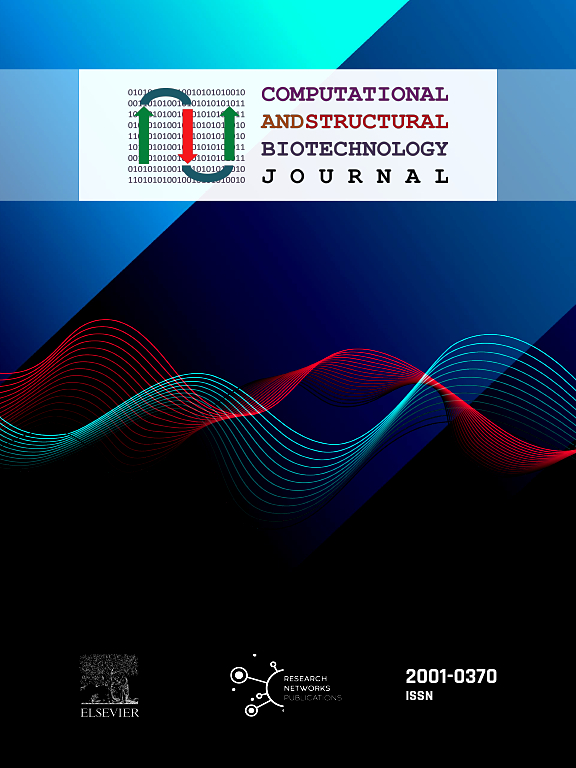Substrate binding of human and bacterial type IA topoisomerase: An experimentation with AlphaFold 3.0
IF 4.4
2区 生物学
Q2 BIOCHEMISTRY & MOLECULAR BIOLOGY
Computational and structural biotechnology journal
Pub Date : 2025-01-01
DOI:10.1016/j.csbj.2025.03.041
引用次数: 0
Abstract
Advancements in biophysical techniques such as X-ray crystallography and Cryo-EM have allowed the determination of three-dimensional structures of many proteins and nucleic acids. There, however, is still a lack of 3D structures of proteins that are difficult to crystallize or proteins in complex with other macromolecules. With the advent of deep learning applications such as AlphaFold and RoseTTAFold, it is becoming possible to obtain 3D structures of proteins from their 1D sequences while also generating models of protein-nucleic acid complexes that have been difficult to capture through traditional methods. In this project, we utilized AlphaFold3 (AF3) to create a large number of predicted complexes of two type IA topoisomerases: human topoisomerase 3 beta (hTOP3B) and Mycobacterium tuberculosis topoisomerase I bound to a single-stranded DNA (ssDNA). Topoisomerases are enzymes responsible for resolving topological barriers that arise during regular cellular activity. Obtaining structures of topoisomerase complexed with a ssDNA will allow us to discover possible sequence preferences of this enzyme and obtain structures that can be used to screen potential inhibitors. Our analysis showed that AF3 can predict the structure of the enzymes, especially the N-terminal domain, with high confidence. However, predicted protein-DNA complexes, especially with longer (> 25-mer) oligos, are unreliable. The models generated with shorter (9-mer) oligos are obtained with improved confidence and the substrates are placed similarly to crystal structures, but they do not reliably replicate the sequence specificity of the DNA binding of topoisomerase observed in biochemical assays and crystal structures.
人与细菌IA型拓扑异构酶的底物结合:用AlphaFold 3.0进行的实验
生物物理技术的进步,如x射线晶体学和低温电子显微镜,使许多蛋白质和核酸的三维结构的测定成为可能。然而,目前仍然缺乏难以结晶的蛋白质的三维结构或与其他大分子复合物的蛋白质。随着AlphaFold和RoseTTAFold等深度学习应用的出现,从蛋白质的1D序列中获得蛋白质的3D结构成为可能,同时还可以生成传统方法难以捕获的蛋白质-核酸复合物模型。在本项目中,我们利用AlphaFold3 (AF3)构建了大量预测的两种IA型拓扑异构酶的复合物:人类拓扑异构酶3 β (hTOP3B)和结核分枝杆菌拓扑异构酶I结合单链DNA (ssDNA)。拓扑异构酶是负责解决在正常细胞活动中产生的拓扑障碍的酶。获得拓扑异构酶与ssDNA络合的结构将使我们能够发现这种酶可能的序列偏好,并获得可用于筛选潜在抑制剂的结构。我们的分析表明,AF3可以预测酶的结构,特别是n端结构域,具有很高的置信度。然而,预测的蛋白质- dna复合物,特别是长(>;25人的寡头是不可靠的。由较短的(9-mer)寡核苷酸生成的模型具有更高的置信度,底物的放置与晶体结构相似,但它们不能可靠地复制生化分析和晶体结构中观察到的拓扑异构酶DNA结合的序列特异性。
本文章由计算机程序翻译,如有差异,请以英文原文为准。
求助全文
约1分钟内获得全文
求助全文
来源期刊

Computational and structural biotechnology journal
Biochemistry, Genetics and Molecular Biology-Biophysics
CiteScore
9.30
自引率
3.30%
发文量
540
审稿时长
6 weeks
期刊介绍:
Computational and Structural Biotechnology Journal (CSBJ) is an online gold open access journal publishing research articles and reviews after full peer review. All articles are published, without barriers to access, immediately upon acceptance. The journal places a strong emphasis on functional and mechanistic understanding of how molecular components in a biological process work together through the application of computational methods. Structural data may provide such insights, but they are not a pre-requisite for publication in the journal. Specific areas of interest include, but are not limited to:
Structure and function of proteins, nucleic acids and other macromolecules
Structure and function of multi-component complexes
Protein folding, processing and degradation
Enzymology
Computational and structural studies of plant systems
Microbial Informatics
Genomics
Proteomics
Metabolomics
Algorithms and Hypothesis in Bioinformatics
Mathematical and Theoretical Biology
Computational Chemistry and Drug Discovery
Microscopy and Molecular Imaging
Nanotechnology
Systems and Synthetic Biology
 求助内容:
求助内容: 应助结果提醒方式:
应助结果提醒方式:


